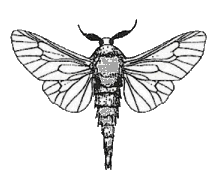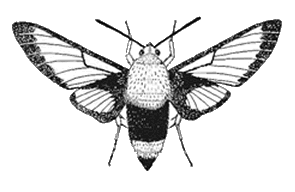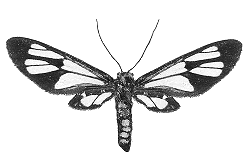Kwik-Key to Common Families of Lepidoptera
Answer for your specimen:
If you have reached this part of the key, your specimen should lack pigmented scales on a substantial part of the hind wings (and sometimes also the front wings).
The four likely families are:
Psychidae
Bagworm moths
Uniformly dark brown or black in color with a tapered abdomen, feathery antennae, and vestigial mouthparts. Wingless females remain inside a spindle-shaped case of leaves or twigs that the larvae build as they grow. Adult males are winged, but relatively short-lived.

Sphingidae
Hawk moths
Sometimes mistaken for hummingbirds, these clear-winged hawk moths are often seen hovering near flowers. They have a plump body with a tapering abdomen. Front wings are elongate and rather pointed; hind wings are much shorter and fan-shaped. Antennae are thickest near the midpoint.

Sesiidae
Clearwing moths
Members of this family are diurnally active moths that often resemble wasps. Most species have narrow bands of yellow, gold, or orange across their abdominal segments. Larvae are mostly borers in the stems or roots of woody plants. Many of them are regarded as agricultural pests.

Erebidae
Wasp moths
These distinctive moths are part of the subfamily arctiinae (within the family Erebidae). Most members are diurnally active and may resemble wasps due to their narrow wings and rapid flight. Common species are dark or metallic in color with yellow or red markings on the body or wings.


